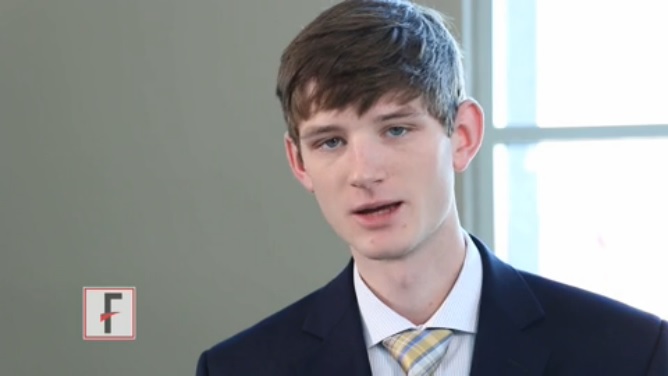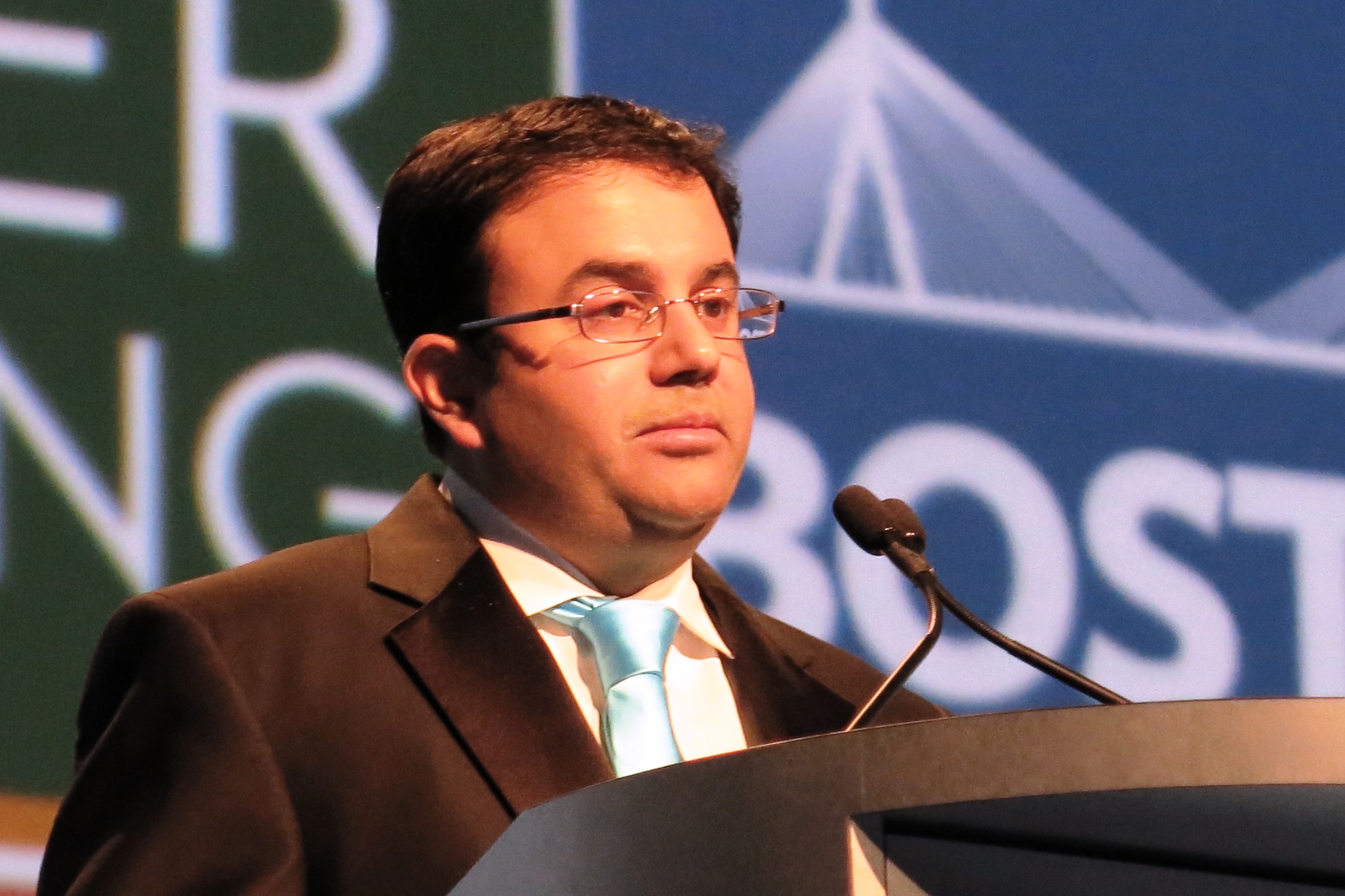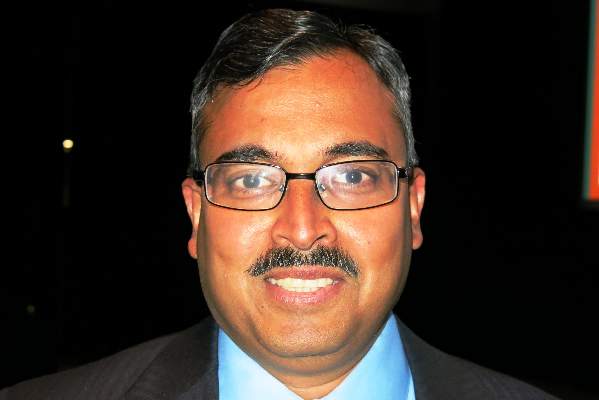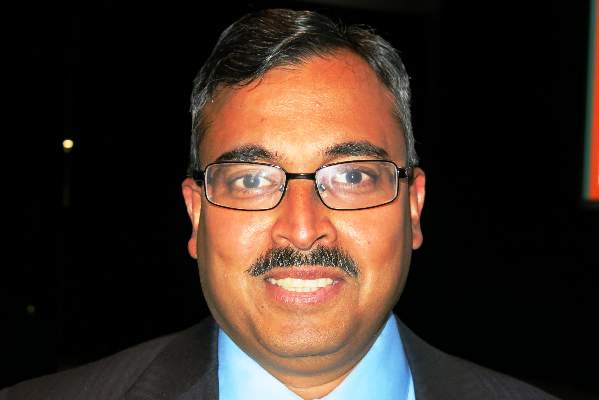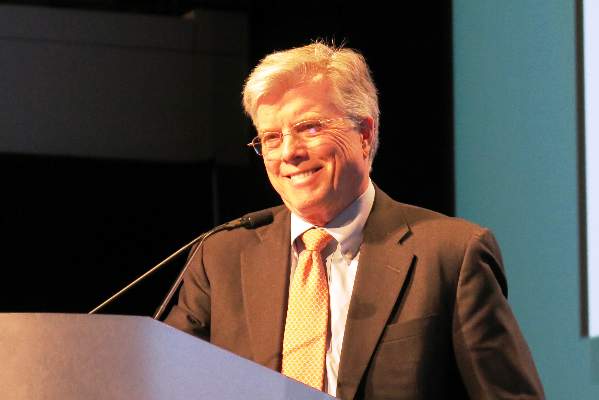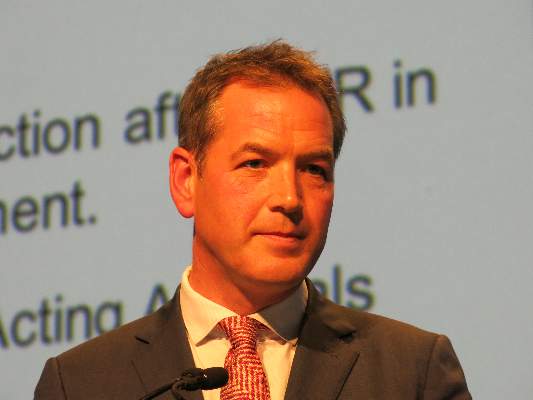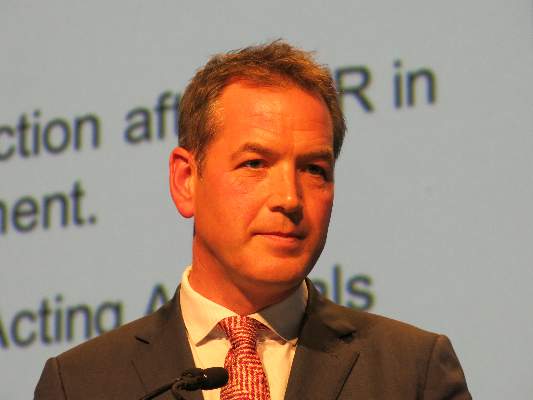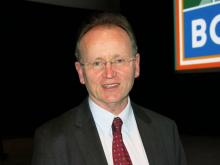User login
American Association for the Study of Liver Disease (AASLD): The Liver Meeting
VIDEO: Most baby boomers didn’t know their hep C status
BOSTON– Almost two-thirds of baby boomers presenting to Alabama emergency departments were unaware of their hepatitis C virus status, despite having such high-risk factors as past intravenous drug use or receipt of a blood transfusion prior to 1992.
Equally concerning, only 48% of patients who knew they were HCV positive were aware of some of the highly efficacious treatments now available, study author and medical student Derek Wells of the University of Alabama-Birmingham said in a video interview at the annual meeting of the American Association for the Study of Liver Diseases.
Mr. Wells called for increased awareness among front-line providers to improve screening and help eradicate HCV in the United States.
Mr. Wells reported no financial disclosures.
The video associated with this article is no longer available on this site. Please view all of our videos on the MDedge YouTube channel
BOSTON– Almost two-thirds of baby boomers presenting to Alabama emergency departments were unaware of their hepatitis C virus status, despite having such high-risk factors as past intravenous drug use or receipt of a blood transfusion prior to 1992.
Equally concerning, only 48% of patients who knew they were HCV positive were aware of some of the highly efficacious treatments now available, study author and medical student Derek Wells of the University of Alabama-Birmingham said in a video interview at the annual meeting of the American Association for the Study of Liver Diseases.
Mr. Wells called for increased awareness among front-line providers to improve screening and help eradicate HCV in the United States.
Mr. Wells reported no financial disclosures.
The video associated with this article is no longer available on this site. Please view all of our videos on the MDedge YouTube channel
BOSTON– Almost two-thirds of baby boomers presenting to Alabama emergency departments were unaware of their hepatitis C virus status, despite having such high-risk factors as past intravenous drug use or receipt of a blood transfusion prior to 1992.
Equally concerning, only 48% of patients who knew they were HCV positive were aware of some of the highly efficacious treatments now available, study author and medical student Derek Wells of the University of Alabama-Birmingham said in a video interview at the annual meeting of the American Association for the Study of Liver Diseases.
Mr. Wells called for increased awareness among front-line providers to improve screening and help eradicate HCV in the United States.
Mr. Wells reported no financial disclosures.
The video associated with this article is no longer available on this site. Please view all of our videos on the MDedge YouTube channel
AT THE LIVER MEETING 2014
Interferon-free regimen benefits HCV-infected liver transplant recipients
An oral, interferon-free drug regimen produced a 97% rate of sustained virologic response in liver transplant recipients who had recurrent hepatitis C viral infection – “an historically difficult-to-treat population” at high risk of death who have extremely limited treatment options, according to a study reported at the annual meeting of the American Association for the Study of Liver Diseases.
In an industry-sponsored, open-label phase II trial involving 34 adults with recurrent HCV infection following liver transplantation, 24 weeks of daily ombitasvir plus the ritonavir-boosted protease inhibitor ABT-450 (ABT-50/r), added to dasabuvir and ribavirin, eradicated every patient’s HCV RNA levels within 4 months. Only one patient had a relapse during a further 24 weeks of follow-up, said Dr. Parvez Mantry of the Liver Institute at Methodist Dallas, who presented the data at the meeting.*
Results of the study, which was conducted at 10 transplant centers in the United States and Spain, were presented at the meeting and simultaneously published online Nov. 11 in the New England Journal of Medicine (N. Engl. J. Med. 2014 Nov. 11 [doi: 10.1056/NEJMoa1408921]).
The standard of care for treating recurrent HCV infection after liver transplantation has been 48 weeks of peginterferon with ribavirin, but response rates are relatively low (13%-43%) because of interferon’s toxic effects. Moreover, the agent is known to induce graft injury, reducing both graft and patient survival.
The investigators assessed the safety and efficacy of a tablet formulation combining ombitasvir, a potent NS5A inhibitor, with ABT-50/r, a protease inhibitor that increases peak, trough, and overall drug exposure and allows once-daily dosing. To this was added standard dasabuvir and ribavirin, with ribavirin dosing adjusted according to the treating physician’s discretion to avert adverse hematologic effects in these immunosuppressed transplant recipients. Modified doses of standard calcineurin inhibitors (cyclosporine or tacrolimus) also were recommended for all patients, and low-dose glucocorticoids were permitted as needed.
The study participants were 18-70 years of age (mean age, 59.6 years) and had received liver transplants because of chronic HCV infection a minimum of 1 year previously. They had no or only mild liver fibrosis, were receiving stable cyclosporine- or tacrolimus-based immunosuppression, and were not coinfected with HIV or hepatitis B.
The primary efficacy endpoint was a sustained virologic response (SVR) 12 weeks after treatment was completed. All the study participants achieved an SVR by week 4 of treatment, which persisted in all of them until treatment was completed. At that time, 1 patient relapsed, so the overall SVR rate was 97%. This same SVR rate was sustained through final follow-up at post-treatment week 24.
In the patient who relapsed, HCV DNA showed resistance-associated genetic variants that had not been present at baseline. This patient also had been unresponsive to previous peginterferon-ribavirin therapy.
Adverse events were common, although the majority were mild or moderate in severity. Fatigue, headache, and cough were the most frequent adverse events. Grade 2 elevations in total bilirubin developed in two patients (6%), with no jaundice or scleral icterus. Nine patients showed grade 2 decreases in hemoglobin; none required a blood transfusion, and five required erythropoietin. There were no deaths and no cases of graft rejection.
One patient discontinued the study drug at week 18 after developing moderate rash, memory impairment, and anxiety deemed to be possibly drug related. However, that patient had already achieved an SVR before discontinuing treatment, and that SVR persisted at final follow-up 12 weeks later.
However, this study was not large enough to allow adequate assessment of adverse event rates or comparison of them with rates for other treatments, the investigators noted.
The researchers also noted that these study participants were easier to treat than the general population of liver transplant recipients with recurrent HCV, because they did not have advanced fibrosis or comorbid infections. In addition, patients with early, aggressive forms of recurrent HCV, such as fibrosing cholestatic hepatitis, were excluded from this study, as were patients maintained on immunosuppressive agents other than cyclosporine or tacrolimus.
This trial was sponsored by AbbVie, whose employees also designed the study, gathered and analyzed the data, and wrote the report. Study investigator Dr. Paul Y. Kwo reported receiving personal fees and grants from, and serving on advisory boards for, AbbVie, Bristol-Myers Squibb, and other companies. His associates reported ties to numerous industry sources.
AGA Resource:
HCV Clinical Service Line: http://www.gastro.org/practice/clinical-service-line/hcv-clinical-service-line
An oral, interferon-free drug regimen produced a 97% rate of sustained virologic response in liver transplant recipients who had recurrent hepatitis C viral infection – “an historically difficult-to-treat population” at high risk of death who have extremely limited treatment options, according to a study reported at the annual meeting of the American Association for the Study of Liver Diseases.
In an industry-sponsored, open-label phase II trial involving 34 adults with recurrent HCV infection following liver transplantation, 24 weeks of daily ombitasvir plus the ritonavir-boosted protease inhibitor ABT-450 (ABT-50/r), added to dasabuvir and ribavirin, eradicated every patient’s HCV RNA levels within 4 months. Only one patient had a relapse during a further 24 weeks of follow-up, said Dr. Parvez Mantry of the Liver Institute at Methodist Dallas, who presented the data at the meeting.*
Results of the study, which was conducted at 10 transplant centers in the United States and Spain, were presented at the meeting and simultaneously published online Nov. 11 in the New England Journal of Medicine (N. Engl. J. Med. 2014 Nov. 11 [doi: 10.1056/NEJMoa1408921]).
The standard of care for treating recurrent HCV infection after liver transplantation has been 48 weeks of peginterferon with ribavirin, but response rates are relatively low (13%-43%) because of interferon’s toxic effects. Moreover, the agent is known to induce graft injury, reducing both graft and patient survival.
The investigators assessed the safety and efficacy of a tablet formulation combining ombitasvir, a potent NS5A inhibitor, with ABT-50/r, a protease inhibitor that increases peak, trough, and overall drug exposure and allows once-daily dosing. To this was added standard dasabuvir and ribavirin, with ribavirin dosing adjusted according to the treating physician’s discretion to avert adverse hematologic effects in these immunosuppressed transplant recipients. Modified doses of standard calcineurin inhibitors (cyclosporine or tacrolimus) also were recommended for all patients, and low-dose glucocorticoids were permitted as needed.
The study participants were 18-70 years of age (mean age, 59.6 years) and had received liver transplants because of chronic HCV infection a minimum of 1 year previously. They had no or only mild liver fibrosis, were receiving stable cyclosporine- or tacrolimus-based immunosuppression, and were not coinfected with HIV or hepatitis B.
The primary efficacy endpoint was a sustained virologic response (SVR) 12 weeks after treatment was completed. All the study participants achieved an SVR by week 4 of treatment, which persisted in all of them until treatment was completed. At that time, 1 patient relapsed, so the overall SVR rate was 97%. This same SVR rate was sustained through final follow-up at post-treatment week 24.
In the patient who relapsed, HCV DNA showed resistance-associated genetic variants that had not been present at baseline. This patient also had been unresponsive to previous peginterferon-ribavirin therapy.
Adverse events were common, although the majority were mild or moderate in severity. Fatigue, headache, and cough were the most frequent adverse events. Grade 2 elevations in total bilirubin developed in two patients (6%), with no jaundice or scleral icterus. Nine patients showed grade 2 decreases in hemoglobin; none required a blood transfusion, and five required erythropoietin. There were no deaths and no cases of graft rejection.
One patient discontinued the study drug at week 18 after developing moderate rash, memory impairment, and anxiety deemed to be possibly drug related. However, that patient had already achieved an SVR before discontinuing treatment, and that SVR persisted at final follow-up 12 weeks later.
However, this study was not large enough to allow adequate assessment of adverse event rates or comparison of them with rates for other treatments, the investigators noted.
The researchers also noted that these study participants were easier to treat than the general population of liver transplant recipients with recurrent HCV, because they did not have advanced fibrosis or comorbid infections. In addition, patients with early, aggressive forms of recurrent HCV, such as fibrosing cholestatic hepatitis, were excluded from this study, as were patients maintained on immunosuppressive agents other than cyclosporine or tacrolimus.
This trial was sponsored by AbbVie, whose employees also designed the study, gathered and analyzed the data, and wrote the report. Study investigator Dr. Paul Y. Kwo reported receiving personal fees and grants from, and serving on advisory boards for, AbbVie, Bristol-Myers Squibb, and other companies. His associates reported ties to numerous industry sources.
AGA Resource:
HCV Clinical Service Line: http://www.gastro.org/practice/clinical-service-line/hcv-clinical-service-line
An oral, interferon-free drug regimen produced a 97% rate of sustained virologic response in liver transplant recipients who had recurrent hepatitis C viral infection – “an historically difficult-to-treat population” at high risk of death who have extremely limited treatment options, according to a study reported at the annual meeting of the American Association for the Study of Liver Diseases.
In an industry-sponsored, open-label phase II trial involving 34 adults with recurrent HCV infection following liver transplantation, 24 weeks of daily ombitasvir plus the ritonavir-boosted protease inhibitor ABT-450 (ABT-50/r), added to dasabuvir and ribavirin, eradicated every patient’s HCV RNA levels within 4 months. Only one patient had a relapse during a further 24 weeks of follow-up, said Dr. Parvez Mantry of the Liver Institute at Methodist Dallas, who presented the data at the meeting.*
Results of the study, which was conducted at 10 transplant centers in the United States and Spain, were presented at the meeting and simultaneously published online Nov. 11 in the New England Journal of Medicine (N. Engl. J. Med. 2014 Nov. 11 [doi: 10.1056/NEJMoa1408921]).
The standard of care for treating recurrent HCV infection after liver transplantation has been 48 weeks of peginterferon with ribavirin, but response rates are relatively low (13%-43%) because of interferon’s toxic effects. Moreover, the agent is known to induce graft injury, reducing both graft and patient survival.
The investigators assessed the safety and efficacy of a tablet formulation combining ombitasvir, a potent NS5A inhibitor, with ABT-50/r, a protease inhibitor that increases peak, trough, and overall drug exposure and allows once-daily dosing. To this was added standard dasabuvir and ribavirin, with ribavirin dosing adjusted according to the treating physician’s discretion to avert adverse hematologic effects in these immunosuppressed transplant recipients. Modified doses of standard calcineurin inhibitors (cyclosporine or tacrolimus) also were recommended for all patients, and low-dose glucocorticoids were permitted as needed.
The study participants were 18-70 years of age (mean age, 59.6 years) and had received liver transplants because of chronic HCV infection a minimum of 1 year previously. They had no or only mild liver fibrosis, were receiving stable cyclosporine- or tacrolimus-based immunosuppression, and were not coinfected with HIV or hepatitis B.
The primary efficacy endpoint was a sustained virologic response (SVR) 12 weeks after treatment was completed. All the study participants achieved an SVR by week 4 of treatment, which persisted in all of them until treatment was completed. At that time, 1 patient relapsed, so the overall SVR rate was 97%. This same SVR rate was sustained through final follow-up at post-treatment week 24.
In the patient who relapsed, HCV DNA showed resistance-associated genetic variants that had not been present at baseline. This patient also had been unresponsive to previous peginterferon-ribavirin therapy.
Adverse events were common, although the majority were mild or moderate in severity. Fatigue, headache, and cough were the most frequent adverse events. Grade 2 elevations in total bilirubin developed in two patients (6%), with no jaundice or scleral icterus. Nine patients showed grade 2 decreases in hemoglobin; none required a blood transfusion, and five required erythropoietin. There were no deaths and no cases of graft rejection.
One patient discontinued the study drug at week 18 after developing moderate rash, memory impairment, and anxiety deemed to be possibly drug related. However, that patient had already achieved an SVR before discontinuing treatment, and that SVR persisted at final follow-up 12 weeks later.
However, this study was not large enough to allow adequate assessment of adverse event rates or comparison of them with rates for other treatments, the investigators noted.
The researchers also noted that these study participants were easier to treat than the general population of liver transplant recipients with recurrent HCV, because they did not have advanced fibrosis or comorbid infections. In addition, patients with early, aggressive forms of recurrent HCV, such as fibrosing cholestatic hepatitis, were excluded from this study, as were patients maintained on immunosuppressive agents other than cyclosporine or tacrolimus.
This trial was sponsored by AbbVie, whose employees also designed the study, gathered and analyzed the data, and wrote the report. Study investigator Dr. Paul Y. Kwo reported receiving personal fees and grants from, and serving on advisory boards for, AbbVie, Bristol-Myers Squibb, and other companies. His associates reported ties to numerous industry sources.
AGA Resource:
HCV Clinical Service Line: http://www.gastro.org/practice/clinical-service-line/hcv-clinical-service-line
Key clinical point: An oral, interferon-free drug combination produced a 97% sustained virologic response rate in liver transplant recipients with recurrent HCV infection.
Major finding: The primary efficacy endpoint, an SVR 12 weeks after completion of treatment, was 97% (33 of 34 patients).
Data source: An industry-sponsored, multicenter, open-label phase II trial involving 34 adults with chronic HCV infection despite liver transplantation.
Disclosures: This trial was sponsored by AbbVie, whose employees also designed the study, gathered and analyzed the data, and wrote the report. Dr. Kwo reported receiving personal fees and grants from, and serving on advisory boards for, AbbVie, Bristol-Myers Squibb, and other companies. His associates reported ties to numerous industry sources.
Interferon-free regimen benefits HCV-infected liver transplant recipients
An oral, interferon-free drug regimen produced a 97% rate of sustained virologic response in liver transplant recipients who had recurrent hepatitis C viral infection – “an historically difficult-to-treat population” at high risk of death who have extremely limited treatment options, according to a study reported at the annual meeting of the American Association for the Study of Liver Diseases.
In an industry-sponsored, open-label phase II trial involving 34 adults with recurrent HCV infection following liver transplantation, 24 weeks of daily ombitasvir plus the ritonavir-boosted protease inhibitor ABT-450 (ABT-50/r), added to dasabuvir and ribavirin, eradicated every patient’s HCV RNA levels within 4 months. Only one patient had a relapse during a further 24 weeks of follow-up, said Dr. Parvez Mantry of the Liver Institute at Methodist Dallas, who presented the data at the meeting.*
Results of the study, which was conducted at 10 transplant centers in the United States and Spain, were presented at the meeting and simultaneously published online Nov. 11 in the New England Journal of Medicine (N. Engl. J. Med. 2014 Nov. 11 [doi: 10.1056/NEJMoa1408921]).
The standard of care for treating recurrent HCV infection after liver transplantation has been 48 weeks of peginterferon with ribavirin, but response rates are relatively low (13%-43%) because of interferon’s toxic effects. Moreover, the agent is known to induce graft injury, reducing both graft and patient survival.
The investigators assessed the safety and efficacy of a tablet formulation combining ombitasvir, a potent NS5A inhibitor, with ABT-50/r, a protease inhibitor that increases peak, trough, and overall drug exposure and allows once-daily dosing. To this was added standard dasabuvir and ribavirin, with ribavirin dosing adjusted according to the treating physician’s discretion to avert adverse hematologic effects in these immunosuppressed transplant recipients. Modified doses of standard calcineurin inhibitors (cyclosporine or tacrolimus) also were recommended for all patients, and low-dose glucocorticoids were permitted as needed.
The study participants were 18-70 years of age (mean age, 59.6 years) and had received liver transplants because of chronic HCV infection a minimum of 1 year previously. They had no or only mild liver fibrosis, were receiving stable cyclosporine- or tacrolimus-based immunosuppression, and were not coinfected with HIV or hepatitis B.
The primary efficacy endpoint was a sustained virologic response (SVR) 12 weeks after treatment was completed. All the study participants achieved an SVR by week 4 of treatment, which persisted in all of them until treatment was completed. At that time, 1 patient relapsed, so the overall SVR rate was 97%. This same SVR rate was sustained through final follow-up at post-treatment week 24.
In the patient who relapsed, HCV DNA showed resistance-associated genetic variants that had not been present at baseline. This patient also had been unresponsive to previous peginterferon-ribavirin therapy.
Adverse events were common, although the majority were mild or moderate in severity. Fatigue, headache, and cough were the most frequent adverse events. Grade 2 elevations in total bilirubin developed in two patients (6%), with no jaundice or scleral icterus. Nine patients showed grade 2 decreases in hemoglobin; none required a blood transfusion, and five required erythropoietin. There were no deaths and no cases of graft rejection.
One patient discontinued the study drug at week 18 after developing moderate rash, memory impairment, and anxiety deemed to be possibly drug related. However, that patient had already achieved an SVR before discontinuing treatment, and that SVR persisted at final follow-up 12 weeks later.
However, this study was not large enough to allow adequate assessment of adverse event rates or comparison of them with rates for other treatments, the investigators noted.
The researchers also noted that these study participants were easier to treat than the general population of liver transplant recipients with recurrent HCV, because they did not have advanced fibrosis or comorbid infections. In addition, patients with early, aggressive forms of recurrent HCV, such as fibrosing cholestatic hepatitis, were excluded from this study, as were patients maintained on immunosuppressive agents other than cyclosporine or tacrolimus.
This trial was sponsored by AbbVie, whose employees also designed the study, gathered and analyzed the data, and wrote the report. Study investigator Dr. Paul Y. Kwo reported receiving personal fees and grants from, and serving on advisory boards for, AbbVie, Bristol-Myers Squibb, and other companies. His associates reported ties to numerous industry sources.
*Clarification, 11/11/14: A previous version of this story did not state that the data were presented by Dr. Mantry
An oral, interferon-free drug regimen produced a 97% rate of sustained virologic response in liver transplant recipients who had recurrent hepatitis C viral infection – “an historically difficult-to-treat population” at high risk of death who have extremely limited treatment options, according to a study reported at the annual meeting of the American Association for the Study of Liver Diseases.
In an industry-sponsored, open-label phase II trial involving 34 adults with recurrent HCV infection following liver transplantation, 24 weeks of daily ombitasvir plus the ritonavir-boosted protease inhibitor ABT-450 (ABT-50/r), added to dasabuvir and ribavirin, eradicated every patient’s HCV RNA levels within 4 months. Only one patient had a relapse during a further 24 weeks of follow-up, said Dr. Parvez Mantry of the Liver Institute at Methodist Dallas, who presented the data at the meeting.*
Results of the study, which was conducted at 10 transplant centers in the United States and Spain, were presented at the meeting and simultaneously published online Nov. 11 in the New England Journal of Medicine (N. Engl. J. Med. 2014 Nov. 11 [doi: 10.1056/NEJMoa1408921]).
The standard of care for treating recurrent HCV infection after liver transplantation has been 48 weeks of peginterferon with ribavirin, but response rates are relatively low (13%-43%) because of interferon’s toxic effects. Moreover, the agent is known to induce graft injury, reducing both graft and patient survival.
The investigators assessed the safety and efficacy of a tablet formulation combining ombitasvir, a potent NS5A inhibitor, with ABT-50/r, a protease inhibitor that increases peak, trough, and overall drug exposure and allows once-daily dosing. To this was added standard dasabuvir and ribavirin, with ribavirin dosing adjusted according to the treating physician’s discretion to avert adverse hematologic effects in these immunosuppressed transplant recipients. Modified doses of standard calcineurin inhibitors (cyclosporine or tacrolimus) also were recommended for all patients, and low-dose glucocorticoids were permitted as needed.
The study participants were 18-70 years of age (mean age, 59.6 years) and had received liver transplants because of chronic HCV infection a minimum of 1 year previously. They had no or only mild liver fibrosis, were receiving stable cyclosporine- or tacrolimus-based immunosuppression, and were not coinfected with HIV or hepatitis B.
The primary efficacy endpoint was a sustained virologic response (SVR) 12 weeks after treatment was completed. All the study participants achieved an SVR by week 4 of treatment, which persisted in all of them until treatment was completed. At that time, 1 patient relapsed, so the overall SVR rate was 97%. This same SVR rate was sustained through final follow-up at post-treatment week 24.
In the patient who relapsed, HCV DNA showed resistance-associated genetic variants that had not been present at baseline. This patient also had been unresponsive to previous peginterferon-ribavirin therapy.
Adverse events were common, although the majority were mild or moderate in severity. Fatigue, headache, and cough were the most frequent adverse events. Grade 2 elevations in total bilirubin developed in two patients (6%), with no jaundice or scleral icterus. Nine patients showed grade 2 decreases in hemoglobin; none required a blood transfusion, and five required erythropoietin. There were no deaths and no cases of graft rejection.
One patient discontinued the study drug at week 18 after developing moderate rash, memory impairment, and anxiety deemed to be possibly drug related. However, that patient had already achieved an SVR before discontinuing treatment, and that SVR persisted at final follow-up 12 weeks later.
However, this study was not large enough to allow adequate assessment of adverse event rates or comparison of them with rates for other treatments, the investigators noted.
The researchers also noted that these study participants were easier to treat than the general population of liver transplant recipients with recurrent HCV, because they did not have advanced fibrosis or comorbid infections. In addition, patients with early, aggressive forms of recurrent HCV, such as fibrosing cholestatic hepatitis, were excluded from this study, as were patients maintained on immunosuppressive agents other than cyclosporine or tacrolimus.
This trial was sponsored by AbbVie, whose employees also designed the study, gathered and analyzed the data, and wrote the report. Study investigator Dr. Paul Y. Kwo reported receiving personal fees and grants from, and serving on advisory boards for, AbbVie, Bristol-Myers Squibb, and other companies. His associates reported ties to numerous industry sources.
*Clarification, 11/11/14: A previous version of this story did not state that the data were presented by Dr. Mantry
An oral, interferon-free drug regimen produced a 97% rate of sustained virologic response in liver transplant recipients who had recurrent hepatitis C viral infection – “an historically difficult-to-treat population” at high risk of death who have extremely limited treatment options, according to a study reported at the annual meeting of the American Association for the Study of Liver Diseases.
In an industry-sponsored, open-label phase II trial involving 34 adults with recurrent HCV infection following liver transplantation, 24 weeks of daily ombitasvir plus the ritonavir-boosted protease inhibitor ABT-450 (ABT-50/r), added to dasabuvir and ribavirin, eradicated every patient’s HCV RNA levels within 4 months. Only one patient had a relapse during a further 24 weeks of follow-up, said Dr. Parvez Mantry of the Liver Institute at Methodist Dallas, who presented the data at the meeting.*
Results of the study, which was conducted at 10 transplant centers in the United States and Spain, were presented at the meeting and simultaneously published online Nov. 11 in the New England Journal of Medicine (N. Engl. J. Med. 2014 Nov. 11 [doi: 10.1056/NEJMoa1408921]).
The standard of care for treating recurrent HCV infection after liver transplantation has been 48 weeks of peginterferon with ribavirin, but response rates are relatively low (13%-43%) because of interferon’s toxic effects. Moreover, the agent is known to induce graft injury, reducing both graft and patient survival.
The investigators assessed the safety and efficacy of a tablet formulation combining ombitasvir, a potent NS5A inhibitor, with ABT-50/r, a protease inhibitor that increases peak, trough, and overall drug exposure and allows once-daily dosing. To this was added standard dasabuvir and ribavirin, with ribavirin dosing adjusted according to the treating physician’s discretion to avert adverse hematologic effects in these immunosuppressed transplant recipients. Modified doses of standard calcineurin inhibitors (cyclosporine or tacrolimus) also were recommended for all patients, and low-dose glucocorticoids were permitted as needed.
The study participants were 18-70 years of age (mean age, 59.6 years) and had received liver transplants because of chronic HCV infection a minimum of 1 year previously. They had no or only mild liver fibrosis, were receiving stable cyclosporine- or tacrolimus-based immunosuppression, and were not coinfected with HIV or hepatitis B.
The primary efficacy endpoint was a sustained virologic response (SVR) 12 weeks after treatment was completed. All the study participants achieved an SVR by week 4 of treatment, which persisted in all of them until treatment was completed. At that time, 1 patient relapsed, so the overall SVR rate was 97%. This same SVR rate was sustained through final follow-up at post-treatment week 24.
In the patient who relapsed, HCV DNA showed resistance-associated genetic variants that had not been present at baseline. This patient also had been unresponsive to previous peginterferon-ribavirin therapy.
Adverse events were common, although the majority were mild or moderate in severity. Fatigue, headache, and cough were the most frequent adverse events. Grade 2 elevations in total bilirubin developed in two patients (6%), with no jaundice or scleral icterus. Nine patients showed grade 2 decreases in hemoglobin; none required a blood transfusion, and five required erythropoietin. There were no deaths and no cases of graft rejection.
One patient discontinued the study drug at week 18 after developing moderate rash, memory impairment, and anxiety deemed to be possibly drug related. However, that patient had already achieved an SVR before discontinuing treatment, and that SVR persisted at final follow-up 12 weeks later.
However, this study was not large enough to allow adequate assessment of adverse event rates or comparison of them with rates for other treatments, the investigators noted.
The researchers also noted that these study participants were easier to treat than the general population of liver transplant recipients with recurrent HCV, because they did not have advanced fibrosis or comorbid infections. In addition, patients with early, aggressive forms of recurrent HCV, such as fibrosing cholestatic hepatitis, were excluded from this study, as were patients maintained on immunosuppressive agents other than cyclosporine or tacrolimus.
This trial was sponsored by AbbVie, whose employees also designed the study, gathered and analyzed the data, and wrote the report. Study investigator Dr. Paul Y. Kwo reported receiving personal fees and grants from, and serving on advisory boards for, AbbVie, Bristol-Myers Squibb, and other companies. His associates reported ties to numerous industry sources.
*Clarification, 11/11/14: A previous version of this story did not state that the data were presented by Dr. Mantry
Key clinical point: An oral, interferon-free drug combination produced a 97% sustained virologic response rate in liver transplant recipients with recurrent HCV infection.
Major finding: The primary efficacy endpoint, an SVR 12 weeks after completion of treatment, was 97% (33 of 34 patients).
Data source: An industry-sponsored, multicenter, open-label phase II trial involving 34 adults with chronic HCV infection despite liver transplantation.
Disclosures: This trial was sponsored by AbbVie, whose employees also designed the study, gathered and analyzed the data, and wrote the report. Dr. Kwo reported receiving personal fees and grants from, and serving on advisory boards for, AbbVie, Bristol-Myers Squibb, and other companies. His associates reported ties to numerous industry sources.
Drug Combination Successful in Hepatitis C Plus HIV
BOSTON – Treating hepatitis C with a combination of ledipasvir and sofosbuvir produced a sustained virologic response in 49 of 50 patients coinfected with genotype 1 hepatitis C and HIV (98%).
Older, interferon-based treatment regimens for hepatitis C historically have not worked well in patients coinfected with hepatitis C and HIV, Dr. Shyamasundaran Kottilil noted at the annual meeting of the American Association for the Study of Liver Diseases.
The fixed-dose combination – containing 90 mg of ledipasvir and 400 mg of sofosbuvir – was effective and well tolerated in the current study, suggesting that HIV infection may not be a major determinant of treatment outcome when using this combination therapy, said Dr. Kottilil, who is codirector of Institute of Human Virology’s Clinical Research Unit and associate director for clinical research in the institute’s Division of Clinical Care and Research of the University of Maryland, Baltimore.
He and his associates studied patients who had not been treated for hepatitis C, giving them the fixed-dose combination once daily for 12 weeks.
Among 13 patients who were not on antiretroviral therapy for HIV, 100% achieved a sustained hepatitis C virologic response at 12 weeks.
Patients were permitted to be on anti-HIV antiretroviral combinations containing tenofovir/emtricitabine (Truvada) with efavirenz, rilpivirine, or raltegrevir for HIV viral suppression. Among the 37 patients on antiretrovirals, all but one achieved a sustained virologic response against hepatitis C by week 12. “We are investigating reasons” for the failure in one patient, Dr. Kottilil said.
No changes in HIV RNA levels or renal parameters were seen. There were no serious adverse events related to study drugs and no discontinuations of therapy because of adverse events.
Men made up 74% of the cohort, and 84% of patients were African American. The mean age was 57 years, 74% had genotype 1a infection, and 78% had an early disease Hepatic Activity Index fibrosis score below 2.
Dr. Kottilil reported having no financial disclosures. Three of his associates reported ties with Gilead Sciences.
BOSTON – Treating hepatitis C with a combination of ledipasvir and sofosbuvir produced a sustained virologic response in 49 of 50 patients coinfected with genotype 1 hepatitis C and HIV (98%).
Older, interferon-based treatment regimens for hepatitis C historically have not worked well in patients coinfected with hepatitis C and HIV, Dr. Shyamasundaran Kottilil noted at the annual meeting of the American Association for the Study of Liver Diseases.
The fixed-dose combination – containing 90 mg of ledipasvir and 400 mg of sofosbuvir – was effective and well tolerated in the current study, suggesting that HIV infection may not be a major determinant of treatment outcome when using this combination therapy, said Dr. Kottilil, who is codirector of Institute of Human Virology’s Clinical Research Unit and associate director for clinical research in the institute’s Division of Clinical Care and Research of the University of Maryland, Baltimore.
He and his associates studied patients who had not been treated for hepatitis C, giving them the fixed-dose combination once daily for 12 weeks.
Among 13 patients who were not on antiretroviral therapy for HIV, 100% achieved a sustained hepatitis C virologic response at 12 weeks.
Patients were permitted to be on anti-HIV antiretroviral combinations containing tenofovir/emtricitabine (Truvada) with efavirenz, rilpivirine, or raltegrevir for HIV viral suppression. Among the 37 patients on antiretrovirals, all but one achieved a sustained virologic response against hepatitis C by week 12. “We are investigating reasons” for the failure in one patient, Dr. Kottilil said.
No changes in HIV RNA levels or renal parameters were seen. There were no serious adverse events related to study drugs and no discontinuations of therapy because of adverse events.
Men made up 74% of the cohort, and 84% of patients were African American. The mean age was 57 years, 74% had genotype 1a infection, and 78% had an early disease Hepatic Activity Index fibrosis score below 2.
Dr. Kottilil reported having no financial disclosures. Three of his associates reported ties with Gilead Sciences.
BOSTON – Treating hepatitis C with a combination of ledipasvir and sofosbuvir produced a sustained virologic response in 49 of 50 patients coinfected with genotype 1 hepatitis C and HIV (98%).
Older, interferon-based treatment regimens for hepatitis C historically have not worked well in patients coinfected with hepatitis C and HIV, Dr. Shyamasundaran Kottilil noted at the annual meeting of the American Association for the Study of Liver Diseases.
The fixed-dose combination – containing 90 mg of ledipasvir and 400 mg of sofosbuvir – was effective and well tolerated in the current study, suggesting that HIV infection may not be a major determinant of treatment outcome when using this combination therapy, said Dr. Kottilil, who is codirector of Institute of Human Virology’s Clinical Research Unit and associate director for clinical research in the institute’s Division of Clinical Care and Research of the University of Maryland, Baltimore.
He and his associates studied patients who had not been treated for hepatitis C, giving them the fixed-dose combination once daily for 12 weeks.
Among 13 patients who were not on antiretroviral therapy for HIV, 100% achieved a sustained hepatitis C virologic response at 12 weeks.
Patients were permitted to be on anti-HIV antiretroviral combinations containing tenofovir/emtricitabine (Truvada) with efavirenz, rilpivirine, or raltegrevir for HIV viral suppression. Among the 37 patients on antiretrovirals, all but one achieved a sustained virologic response against hepatitis C by week 12. “We are investigating reasons” for the failure in one patient, Dr. Kottilil said.
No changes in HIV RNA levels or renal parameters were seen. There were no serious adverse events related to study drugs and no discontinuations of therapy because of adverse events.
Men made up 74% of the cohort, and 84% of patients were African American. The mean age was 57 years, 74% had genotype 1a infection, and 78% had an early disease Hepatic Activity Index fibrosis score below 2.
Dr. Kottilil reported having no financial disclosures. Three of his associates reported ties with Gilead Sciences.
AT THE LIVER MEETING 2014
Drug combination successful in hepatitis C plus HIV
BOSTON – Treating hepatitis C with a combination of ledipasvir and sofosbuvir produced a sustained virologic response in 49 of 50 patients coinfected with genotype 1 hepatitis C and HIV (98%).
Older, interferon-based treatment regimens for hepatitis C historically have not worked well in patients coinfected with hepatitis C and HIV, Dr. Shyamasundaran Kottilil noted at the annual meeting of the American Association for the Study of Liver Diseases.
The fixed-dose combination – containing 90 mg of ledipasvir and 400 mg of sofosbuvir – was effective and well tolerated in the current study, suggesting that HIV infection may not be a major determinant of treatment outcome when using this combination therapy, said Dr. Kottilil, who is codirector of Institute of Human Virology’s Clinical Research Unit and associate director for clinical research in the institute’s Division of Clinical Care and Research of the University of Maryland, Baltimore.
He and his associates studied patients who had not been treated for hepatitis C, giving them the fixed-dose combination once daily for 12 weeks.
Among 13 patients who were not on antiretroviral therapy for HIV, 100% achieved a sustained hepatitis C virologic response at 12 weeks.
Patients were permitted to be on anti-HIV antiretroviral combinations containing tenofovir/emtricitabine (Truvada) with efavirenz, rilpivirine, or raltegrevir for HIV viral suppression. Among the 37 patients on antiretrovirals, all but one achieved a sustained virologic response against hepatitis C by week 12. “We are investigating reasons” for the failure in one patient, Dr. Kottilil said.
No changes in HIV RNA levels or renal parameters were seen. There were no serious adverse events related to study drugs and no discontinuations of therapy because of adverse events.
Men made up 74% of the cohort, and 84% of patients were African American. The mean age was 57 years, 74% had genotype 1a infection, and 78% had an early disease Hepatic Activity Index fibrosis score below 2.
Dr. Kottilil reported having no financial disclosures. Three of his associates reported ties with Gilead Sciences.
On Twitter @sherryboschert
BOSTON – Treating hepatitis C with a combination of ledipasvir and sofosbuvir produced a sustained virologic response in 49 of 50 patients coinfected with genotype 1 hepatitis C and HIV (98%).
Older, interferon-based treatment regimens for hepatitis C historically have not worked well in patients coinfected with hepatitis C and HIV, Dr. Shyamasundaran Kottilil noted at the annual meeting of the American Association for the Study of Liver Diseases.
The fixed-dose combination – containing 90 mg of ledipasvir and 400 mg of sofosbuvir – was effective and well tolerated in the current study, suggesting that HIV infection may not be a major determinant of treatment outcome when using this combination therapy, said Dr. Kottilil, who is codirector of Institute of Human Virology’s Clinical Research Unit and associate director for clinical research in the institute’s Division of Clinical Care and Research of the University of Maryland, Baltimore.
He and his associates studied patients who had not been treated for hepatitis C, giving them the fixed-dose combination once daily for 12 weeks.
Among 13 patients who were not on antiretroviral therapy for HIV, 100% achieved a sustained hepatitis C virologic response at 12 weeks.
Patients were permitted to be on anti-HIV antiretroviral combinations containing tenofovir/emtricitabine (Truvada) with efavirenz, rilpivirine, or raltegrevir for HIV viral suppression. Among the 37 patients on antiretrovirals, all but one achieved a sustained virologic response against hepatitis C by week 12. “We are investigating reasons” for the failure in one patient, Dr. Kottilil said.
No changes in HIV RNA levels or renal parameters were seen. There were no serious adverse events related to study drugs and no discontinuations of therapy because of adverse events.
Men made up 74% of the cohort, and 84% of patients were African American. The mean age was 57 years, 74% had genotype 1a infection, and 78% had an early disease Hepatic Activity Index fibrosis score below 2.
Dr. Kottilil reported having no financial disclosures. Three of his associates reported ties with Gilead Sciences.
On Twitter @sherryboschert
BOSTON – Treating hepatitis C with a combination of ledipasvir and sofosbuvir produced a sustained virologic response in 49 of 50 patients coinfected with genotype 1 hepatitis C and HIV (98%).
Older, interferon-based treatment regimens for hepatitis C historically have not worked well in patients coinfected with hepatitis C and HIV, Dr. Shyamasundaran Kottilil noted at the annual meeting of the American Association for the Study of Liver Diseases.
The fixed-dose combination – containing 90 mg of ledipasvir and 400 mg of sofosbuvir – was effective and well tolerated in the current study, suggesting that HIV infection may not be a major determinant of treatment outcome when using this combination therapy, said Dr. Kottilil, who is codirector of Institute of Human Virology’s Clinical Research Unit and associate director for clinical research in the institute’s Division of Clinical Care and Research of the University of Maryland, Baltimore.
He and his associates studied patients who had not been treated for hepatitis C, giving them the fixed-dose combination once daily for 12 weeks.
Among 13 patients who were not on antiretroviral therapy for HIV, 100% achieved a sustained hepatitis C virologic response at 12 weeks.
Patients were permitted to be on anti-HIV antiretroviral combinations containing tenofovir/emtricitabine (Truvada) with efavirenz, rilpivirine, or raltegrevir for HIV viral suppression. Among the 37 patients on antiretrovirals, all but one achieved a sustained virologic response against hepatitis C by week 12. “We are investigating reasons” for the failure in one patient, Dr. Kottilil said.
No changes in HIV RNA levels or renal parameters were seen. There were no serious adverse events related to study drugs and no discontinuations of therapy because of adverse events.
Men made up 74% of the cohort, and 84% of patients were African American. The mean age was 57 years, 74% had genotype 1a infection, and 78% had an early disease Hepatic Activity Index fibrosis score below 2.
Dr. Kottilil reported having no financial disclosures. Three of his associates reported ties with Gilead Sciences.
On Twitter @sherryboschert
AT THE LIVER MEETING 2014
Key clinical point: Hepatitis C can be treated successfully in patients with HIV using ledipasvir and sofosbuvir.
Major finding: Ledipasvir plus sofosbuvir for hepatitis C produced a sustained virologic response in 49 of 50 patients (98%).
Data source: A prospective study of 50 patients with genotype 1 hepatitis C infection and HIV.
Disclosures: Dr. Kottilil reported having no financial disclosures. Three of his associates reported ties with Gilead Sciences.
Sofosbuvir-containing regimens dominate hepatitis C treatment
BOSTON – Since their approval in late 2013, the direct-acting antiviral agents sofosbuvir and simeprevir have taken over treatment of hepatitis C with real-world success that approximates clinical trial results, two separate and ongoing longitudinal, observational studies show.
Sofosbuvir-containing regimens produced sustained virologic response (SVR) rates of 85%-90% in patients with genotype 1 infection in one study and 79%-88% in the other.
In one study, researchers analyzed data for 2,063 patients who started and completed treatment for hepatitis C since January 2014 at 43 academic medical centers and 13 community medical centers in North America and Europe participating in the HCV-Target study, Dr. Donald M. Jensen and his associates reported at the annual meeting of the American Association for the Study of Liver Diseases.
Among patients with genotype 1 hepatitis C infection, 68% were treated with an off-label combination of sofosbuvir plus simeprevir with or without ribavirin, 23% received sofosbuvir plus pegylated interferon plus ribavirin, and 9% received sofosbuvir plus ribavirin alone, reported Dr. Jensen, professor of medicine and director of the Center for Liver Diseases at the University of Chicago.
Among patients with genotype 2 or 3 hepatitis C infection, 99% and 92% received sofosbuvir plus ribavirin, respectively.
The off-label combination of sofosbuvir plus simeprevir with or without ribavirin also was common in two subgroups, patients with cirrhosis and patients who had undergone liver transplantation.
That combination – sofosbuvir plus simeprevir with or without ribavirin – produced an SVR at 4 weeks in 89% of patients with genotype 1 hepatitis C, ranging from 92% in patients without cirrhosis to 87% in those with cirrhosis and 75% in patients with prior decompensation, he reported. And if they’d previously failed protease inhibitor therapy, the SVR rate at 4 weeks was 81%, ranging from 79% in those with cirrhosis to 85% without cirrhosis.
Treating patients with genotype 1 infection with sofosbuvir plus pegylated interferon plus ribavirin led to an SVR rate at 4 weeks of 85%, ranging from 70% in cirrhotic patients to 90% without cirrhosis.
In patients with genotype 2 infection, treatment with sofosbuvir plus ribavirin produced an SVR rate at 4 weeks of 90%, ranging from 88% in patients with cirrhosis to 91% without cirrhosis.
A secondary analysis suggested good concordance between SVR rates at 4 weeks and 12 weeks. The positive predictive value for SVR at 12 weeks if there was SVR at 4 weeks was 97% for patients treated with sofosbuvir and simeprevir with or without ribavirin, 94% for those treated with sofosbuvir, pegylated interferon, and ribavirin, and 98% for patients treated with sofosbuvir and ribavirin.
Rates of serious adverse events and premature discontinuation of therapy were “very low,” Dr. Jensen said.
In a separate study of patients who started treatment for hepatitis C between January and April of 2014 at 119 practices, researchers analyzed data on 955 patients who completed treatment. Because SVR rates at 12 weeks are pending for some patients, an intent-to-treat analysis included 822 patients and 743 patients who were in a per-protocol analysis.
Forty percent of patients were treated with sofosbuvir plus pegylated interferon and ribavirin, 24% received sofosbuvir and ribavirin, and 34% were treated with sofosbuvir and simeprevir with or without ribavirin, reported Dr. Douglas Dieterich and his associates.
SVR was achieved at 12 weeks by 79% of patients in the intent-to-treat analysis and by 88% in the per-protocol analysis, reported Dr. Dieterich, professor of medicine at Mount Sinai School of Medicine, New York.
“This is comparable to data reported in clinical trials,” he said. Notably, 72% of patients who previously failed treatment and then received sofosbuvir, pegylated interferon, and ribavirin achieved SVR at 12 weeks, “exactly as predicted by the Food and Drug Administration,” he added.
Dr. Dieterich reported ties with Merck, Idenix Pharmaceuticals, Janssen Pharmaceuticals, Gilead, and Bristol-Myers Squibb, and his associates reported ties with dozens of companies. Dr. Jensen reported ties with AbbVie, Boehringer Ingelheim, Bristol-Myers Squibb, Genentech/Roche, and Janssen Pharmaceuticals, Gilead, Merck, Vertex, and GSK.
On Twitter @sherryboschert
BOSTON – Since their approval in late 2013, the direct-acting antiviral agents sofosbuvir and simeprevir have taken over treatment of hepatitis C with real-world success that approximates clinical trial results, two separate and ongoing longitudinal, observational studies show.
Sofosbuvir-containing regimens produced sustained virologic response (SVR) rates of 85%-90% in patients with genotype 1 infection in one study and 79%-88% in the other.
In one study, researchers analyzed data for 2,063 patients who started and completed treatment for hepatitis C since January 2014 at 43 academic medical centers and 13 community medical centers in North America and Europe participating in the HCV-Target study, Dr. Donald M. Jensen and his associates reported at the annual meeting of the American Association for the Study of Liver Diseases.
Among patients with genotype 1 hepatitis C infection, 68% were treated with an off-label combination of sofosbuvir plus simeprevir with or without ribavirin, 23% received sofosbuvir plus pegylated interferon plus ribavirin, and 9% received sofosbuvir plus ribavirin alone, reported Dr. Jensen, professor of medicine and director of the Center for Liver Diseases at the University of Chicago.
Among patients with genotype 2 or 3 hepatitis C infection, 99% and 92% received sofosbuvir plus ribavirin, respectively.
The off-label combination of sofosbuvir plus simeprevir with or without ribavirin also was common in two subgroups, patients with cirrhosis and patients who had undergone liver transplantation.
That combination – sofosbuvir plus simeprevir with or without ribavirin – produced an SVR at 4 weeks in 89% of patients with genotype 1 hepatitis C, ranging from 92% in patients without cirrhosis to 87% in those with cirrhosis and 75% in patients with prior decompensation, he reported. And if they’d previously failed protease inhibitor therapy, the SVR rate at 4 weeks was 81%, ranging from 79% in those with cirrhosis to 85% without cirrhosis.
Treating patients with genotype 1 infection with sofosbuvir plus pegylated interferon plus ribavirin led to an SVR rate at 4 weeks of 85%, ranging from 70% in cirrhotic patients to 90% without cirrhosis.
In patients with genotype 2 infection, treatment with sofosbuvir plus ribavirin produced an SVR rate at 4 weeks of 90%, ranging from 88% in patients with cirrhosis to 91% without cirrhosis.
A secondary analysis suggested good concordance between SVR rates at 4 weeks and 12 weeks. The positive predictive value for SVR at 12 weeks if there was SVR at 4 weeks was 97% for patients treated with sofosbuvir and simeprevir with or without ribavirin, 94% for those treated with sofosbuvir, pegylated interferon, and ribavirin, and 98% for patients treated with sofosbuvir and ribavirin.
Rates of serious adverse events and premature discontinuation of therapy were “very low,” Dr. Jensen said.
In a separate study of patients who started treatment for hepatitis C between January and April of 2014 at 119 practices, researchers analyzed data on 955 patients who completed treatment. Because SVR rates at 12 weeks are pending for some patients, an intent-to-treat analysis included 822 patients and 743 patients who were in a per-protocol analysis.
Forty percent of patients were treated with sofosbuvir plus pegylated interferon and ribavirin, 24% received sofosbuvir and ribavirin, and 34% were treated with sofosbuvir and simeprevir with or without ribavirin, reported Dr. Douglas Dieterich and his associates.
SVR was achieved at 12 weeks by 79% of patients in the intent-to-treat analysis and by 88% in the per-protocol analysis, reported Dr. Dieterich, professor of medicine at Mount Sinai School of Medicine, New York.
“This is comparable to data reported in clinical trials,” he said. Notably, 72% of patients who previously failed treatment and then received sofosbuvir, pegylated interferon, and ribavirin achieved SVR at 12 weeks, “exactly as predicted by the Food and Drug Administration,” he added.
Dr. Dieterich reported ties with Merck, Idenix Pharmaceuticals, Janssen Pharmaceuticals, Gilead, and Bristol-Myers Squibb, and his associates reported ties with dozens of companies. Dr. Jensen reported ties with AbbVie, Boehringer Ingelheim, Bristol-Myers Squibb, Genentech/Roche, and Janssen Pharmaceuticals, Gilead, Merck, Vertex, and GSK.
On Twitter @sherryboschert
BOSTON – Since their approval in late 2013, the direct-acting antiviral agents sofosbuvir and simeprevir have taken over treatment of hepatitis C with real-world success that approximates clinical trial results, two separate and ongoing longitudinal, observational studies show.
Sofosbuvir-containing regimens produced sustained virologic response (SVR) rates of 85%-90% in patients with genotype 1 infection in one study and 79%-88% in the other.
In one study, researchers analyzed data for 2,063 patients who started and completed treatment for hepatitis C since January 2014 at 43 academic medical centers and 13 community medical centers in North America and Europe participating in the HCV-Target study, Dr. Donald M. Jensen and his associates reported at the annual meeting of the American Association for the Study of Liver Diseases.
Among patients with genotype 1 hepatitis C infection, 68% were treated with an off-label combination of sofosbuvir plus simeprevir with or without ribavirin, 23% received sofosbuvir plus pegylated interferon plus ribavirin, and 9% received sofosbuvir plus ribavirin alone, reported Dr. Jensen, professor of medicine and director of the Center for Liver Diseases at the University of Chicago.
Among patients with genotype 2 or 3 hepatitis C infection, 99% and 92% received sofosbuvir plus ribavirin, respectively.
The off-label combination of sofosbuvir plus simeprevir with or without ribavirin also was common in two subgroups, patients with cirrhosis and patients who had undergone liver transplantation.
That combination – sofosbuvir plus simeprevir with or without ribavirin – produced an SVR at 4 weeks in 89% of patients with genotype 1 hepatitis C, ranging from 92% in patients without cirrhosis to 87% in those with cirrhosis and 75% in patients with prior decompensation, he reported. And if they’d previously failed protease inhibitor therapy, the SVR rate at 4 weeks was 81%, ranging from 79% in those with cirrhosis to 85% without cirrhosis.
Treating patients with genotype 1 infection with sofosbuvir plus pegylated interferon plus ribavirin led to an SVR rate at 4 weeks of 85%, ranging from 70% in cirrhotic patients to 90% without cirrhosis.
In patients with genotype 2 infection, treatment with sofosbuvir plus ribavirin produced an SVR rate at 4 weeks of 90%, ranging from 88% in patients with cirrhosis to 91% without cirrhosis.
A secondary analysis suggested good concordance between SVR rates at 4 weeks and 12 weeks. The positive predictive value for SVR at 12 weeks if there was SVR at 4 weeks was 97% for patients treated with sofosbuvir and simeprevir with or without ribavirin, 94% for those treated with sofosbuvir, pegylated interferon, and ribavirin, and 98% for patients treated with sofosbuvir and ribavirin.
Rates of serious adverse events and premature discontinuation of therapy were “very low,” Dr. Jensen said.
In a separate study of patients who started treatment for hepatitis C between January and April of 2014 at 119 practices, researchers analyzed data on 955 patients who completed treatment. Because SVR rates at 12 weeks are pending for some patients, an intent-to-treat analysis included 822 patients and 743 patients who were in a per-protocol analysis.
Forty percent of patients were treated with sofosbuvir plus pegylated interferon and ribavirin, 24% received sofosbuvir and ribavirin, and 34% were treated with sofosbuvir and simeprevir with or without ribavirin, reported Dr. Douglas Dieterich and his associates.
SVR was achieved at 12 weeks by 79% of patients in the intent-to-treat analysis and by 88% in the per-protocol analysis, reported Dr. Dieterich, professor of medicine at Mount Sinai School of Medicine, New York.
“This is comparable to data reported in clinical trials,” he said. Notably, 72% of patients who previously failed treatment and then received sofosbuvir, pegylated interferon, and ribavirin achieved SVR at 12 weeks, “exactly as predicted by the Food and Drug Administration,” he added.
Dr. Dieterich reported ties with Merck, Idenix Pharmaceuticals, Janssen Pharmaceuticals, Gilead, and Bristol-Myers Squibb, and his associates reported ties with dozens of companies. Dr. Jensen reported ties with AbbVie, Boehringer Ingelheim, Bristol-Myers Squibb, Genentech/Roche, and Janssen Pharmaceuticals, Gilead, Merck, Vertex, and GSK.
On Twitter @sherryboschert
AT THE LIVER MEETING 2014
Key clinical point: Real-world results with sofosbuvir-containing regimens are consistent with clinical trial results.
Major finding: Sofosbuvir-containing regimens produced sustained virologic response rates of 85%-90% in patients with genotype 1 infection in one study and 79%-88% in the other.
Data source: Two ongoing, multicenter, longitudinal, observational studies with data so far on 2,063 patients and 822 patients with hepatitis C, respectively.
Disclosures: Dr. Jensen reported ties with AbbVie, Boehringer Ingelheim, Bristol-Myers Squibb, Genentech/Roche, Janssen Pharmaceuticals, Gilead, Merck, Kadman, Vertex, and GSK. Dr. Dieterich ties with Merck, Idenix Pharmaceuticals, Janssen Pharmaceuticals, Gilead, and Bristol-Myers Squibb, and his associates reported ties with dozens of companies.
Achieving Sustained Response Key to Successful HCV Treatment
BOSTON – Risks for mortality, hepatocellular carcinoma, and liver transplantations were significantly lower in patients with hepatitis C who achieved a sustained virologic response after treatment, compared with patients without a sustained response, in a meta-analysis of long-term follow-up data on 23,309 patients.
In patients with a sustained virologic response (SVR), the risk of death was 62%-84% lower, the risk of developing hepatocellular carcinoma was 68%-79% lower, and the risk of liver transplantation was 90% lower, compared with patients who did not achieve a SVR, Andrew M. Hill, Ph.D., and his associates reported at the annual meeting of the American Association for the Study of Liver Diseases.
The cohort included 15,067 patients with hepatitis C without cirrhosis, HIV, or prior transplantation; 4,987 patients with hepatitis C and cirrhosis; 1,170 patients with hepatitis C who had undergone liver transplantation; and 2,085 patients coinfected with hepatitis C and HIV.
Treatment consisted primarily of pegylated interferon plus ribavirin. “These analyses need to be repeated for studies of direct acting antivirals,” said Dr. Hill of the University of Liverpool, England.
In the current study, SVR was associated with a 62% reduction in the risk of death in the general group of mono-infected patients without cirrhosis or transplantation, an 84% reduction in patients with cirrhosis, and a 73% reduction in those coinfected with HIV, multivariate analyses showed.
The 5-year risk of all-cause mortality was 4.5% after SVR and 10.5% with no SVR in the general group of patients with HCV. In those with cirrhosis, mortality rates were 3.6% after SVR or 11.3% with no SVR. In patients who also had HIV, mortality rates were 1.3% after SVR and 10% with no SVR, Dr. Hill reported.
The 5-year risk of developing hepatocellular carcinoma as 2.9% after SVR and 9.3% with no SVR in the general group with HCV. In patients with cirrhosis, hepatocellular carcinoma rates were 5.3% with SVR and 13.9% with no SVR. In patients who had HIV, hepatocellular carcinoma rates were 0.9% after SVR and 10% with no SVR.
Reinfection with HCV can complicate the results of treatment, Dr. Hill said. The 5-year reinfection rates were 0.9% in low-risk patients, 8.2% in IV drug users or prisoners, and 23.6% in patients coinfected with HIV.
“The cost-effectiveness of treatment of hepatitis C depends on the extent of reductions in the risk of liver transplantation, hepatocellular carcinoma, and all-cause mortality,” he said.
The World Health Organization and UNITAID funded the study. Dr. Hill reported financial associations with Janssen Pharmaceuticals.
BOSTON – Risks for mortality, hepatocellular carcinoma, and liver transplantations were significantly lower in patients with hepatitis C who achieved a sustained virologic response after treatment, compared with patients without a sustained response, in a meta-analysis of long-term follow-up data on 23,309 patients.
In patients with a sustained virologic response (SVR), the risk of death was 62%-84% lower, the risk of developing hepatocellular carcinoma was 68%-79% lower, and the risk of liver transplantation was 90% lower, compared with patients who did not achieve a SVR, Andrew M. Hill, Ph.D., and his associates reported at the annual meeting of the American Association for the Study of Liver Diseases.
The cohort included 15,067 patients with hepatitis C without cirrhosis, HIV, or prior transplantation; 4,987 patients with hepatitis C and cirrhosis; 1,170 patients with hepatitis C who had undergone liver transplantation; and 2,085 patients coinfected with hepatitis C and HIV.
Treatment consisted primarily of pegylated interferon plus ribavirin. “These analyses need to be repeated for studies of direct acting antivirals,” said Dr. Hill of the University of Liverpool, England.
In the current study, SVR was associated with a 62% reduction in the risk of death in the general group of mono-infected patients without cirrhosis or transplantation, an 84% reduction in patients with cirrhosis, and a 73% reduction in those coinfected with HIV, multivariate analyses showed.
The 5-year risk of all-cause mortality was 4.5% after SVR and 10.5% with no SVR in the general group of patients with HCV. In those with cirrhosis, mortality rates were 3.6% after SVR or 11.3% with no SVR. In patients who also had HIV, mortality rates were 1.3% after SVR and 10% with no SVR, Dr. Hill reported.
The 5-year risk of developing hepatocellular carcinoma as 2.9% after SVR and 9.3% with no SVR in the general group with HCV. In patients with cirrhosis, hepatocellular carcinoma rates were 5.3% with SVR and 13.9% with no SVR. In patients who had HIV, hepatocellular carcinoma rates were 0.9% after SVR and 10% with no SVR.
Reinfection with HCV can complicate the results of treatment, Dr. Hill said. The 5-year reinfection rates were 0.9% in low-risk patients, 8.2% in IV drug users or prisoners, and 23.6% in patients coinfected with HIV.
“The cost-effectiveness of treatment of hepatitis C depends on the extent of reductions in the risk of liver transplantation, hepatocellular carcinoma, and all-cause mortality,” he said.
The World Health Organization and UNITAID funded the study. Dr. Hill reported financial associations with Janssen Pharmaceuticals.
BOSTON – Risks for mortality, hepatocellular carcinoma, and liver transplantations were significantly lower in patients with hepatitis C who achieved a sustained virologic response after treatment, compared with patients without a sustained response, in a meta-analysis of long-term follow-up data on 23,309 patients.
In patients with a sustained virologic response (SVR), the risk of death was 62%-84% lower, the risk of developing hepatocellular carcinoma was 68%-79% lower, and the risk of liver transplantation was 90% lower, compared with patients who did not achieve a SVR, Andrew M. Hill, Ph.D., and his associates reported at the annual meeting of the American Association for the Study of Liver Diseases.
The cohort included 15,067 patients with hepatitis C without cirrhosis, HIV, or prior transplantation; 4,987 patients with hepatitis C and cirrhosis; 1,170 patients with hepatitis C who had undergone liver transplantation; and 2,085 patients coinfected with hepatitis C and HIV.
Treatment consisted primarily of pegylated interferon plus ribavirin. “These analyses need to be repeated for studies of direct acting antivirals,” said Dr. Hill of the University of Liverpool, England.
In the current study, SVR was associated with a 62% reduction in the risk of death in the general group of mono-infected patients without cirrhosis or transplantation, an 84% reduction in patients with cirrhosis, and a 73% reduction in those coinfected with HIV, multivariate analyses showed.
The 5-year risk of all-cause mortality was 4.5% after SVR and 10.5% with no SVR in the general group of patients with HCV. In those with cirrhosis, mortality rates were 3.6% after SVR or 11.3% with no SVR. In patients who also had HIV, mortality rates were 1.3% after SVR and 10% with no SVR, Dr. Hill reported.
The 5-year risk of developing hepatocellular carcinoma as 2.9% after SVR and 9.3% with no SVR in the general group with HCV. In patients with cirrhosis, hepatocellular carcinoma rates were 5.3% with SVR and 13.9% with no SVR. In patients who had HIV, hepatocellular carcinoma rates were 0.9% after SVR and 10% with no SVR.
Reinfection with HCV can complicate the results of treatment, Dr. Hill said. The 5-year reinfection rates were 0.9% in low-risk patients, 8.2% in IV drug users or prisoners, and 23.6% in patients coinfected with HIV.
“The cost-effectiveness of treatment of hepatitis C depends on the extent of reductions in the risk of liver transplantation, hepatocellular carcinoma, and all-cause mortality,” he said.
The World Health Organization and UNITAID funded the study. Dr. Hill reported financial associations with Janssen Pharmaceuticals.
AT THE LIVER MEETING 2014
Achieving sustained response key to successful HCV treatment
BOSTON – Risks for mortality, hepatocellular carcinoma, and liver transplantations were significantly lower in patients with hepatitis C who achieved a sustained virologic response after treatment, compared with patients without a sustained response, in a meta-analysis of long-term follow-up data on 23,309 patients.
In patients with a sustained virologic response (SVR), the risk of death was 62%-84% lower, the risk of developing hepatocellular carcinoma was 68%-79% lower, and the risk of liver transplantation was 90% lower, compared with patients who did not achieve a SVR, Andrew M. Hill, Ph.D., and his associates reported at the annual meeting of the American Association for the Study of Liver Diseases.
The cohort included 15,067 patients with hepatitis C without cirrhosis, HIV, or prior transplantation; 4,987 patients with hepatitis C and cirrhosis; 1,170 patients with hepatitis C who had undergone liver transplantation; and 2,085 patients coinfected with hepatitis C and HIV.
Treatment consisted primarily of pegylated interferon plus ribavirin. “These analyses need to be repeated for studies of direct acting antivirals,” said Dr. Hill of the University of Liverpool, England.
In the current study, SVR was associated with a 62% reduction in the risk of death in the general group of mono-infected patients without cirrhosis or transplantation, an 84% reduction in patients with cirrhosis, and a 73% reduction in those coinfected with HIV, multivariate analyses showed.
The 5-year risk of all-cause mortality was 4.5% after SVR and 10.5% with no SVR in the general group of patients with HCV. In those with cirrhosis, mortality rates were 3.6% after SVR or 11.3% with no SVR. In patients who also had HIV, mortality rates were 1.3% after SVR and 10% with no SVR, Dr. Hill reported.
The 5-year risk of developing hepatocellular carcinoma as 2.9% after SVR and 9.3% with no SVR in the general group with HCV. In patients with cirrhosis, hepatocellular carcinoma rates were 5.3% with SVR and 13.9% with no SVR. In patients who had HIV, hepatocellular carcinoma rates were 0.9% after SVR and 10% with no SVR.
Reinfection with HCV can complicate the results of treatment, Dr. Hill said. The 5-year reinfection rates were 0.9% in low-risk patients, 8.2% in IV drug users or prisoners, and 23.6% in patients coinfected with HIV.
“The cost-effectiveness of treatment of hepatitis C depends on the extent of reductions in the risk of liver transplantation, hepatocellular carcinoma, and all-cause mortality,” he said.
The World Health Organization and UNITAID funded the study. Dr. Hill reported financial associations with Janssen Pharmaceuticals.
On Twitter @sherryboschert
BOSTON – Risks for mortality, hepatocellular carcinoma, and liver transplantations were significantly lower in patients with hepatitis C who achieved a sustained virologic response after treatment, compared with patients without a sustained response, in a meta-analysis of long-term follow-up data on 23,309 patients.
In patients with a sustained virologic response (SVR), the risk of death was 62%-84% lower, the risk of developing hepatocellular carcinoma was 68%-79% lower, and the risk of liver transplantation was 90% lower, compared with patients who did not achieve a SVR, Andrew M. Hill, Ph.D., and his associates reported at the annual meeting of the American Association for the Study of Liver Diseases.
The cohort included 15,067 patients with hepatitis C without cirrhosis, HIV, or prior transplantation; 4,987 patients with hepatitis C and cirrhosis; 1,170 patients with hepatitis C who had undergone liver transplantation; and 2,085 patients coinfected with hepatitis C and HIV.
Treatment consisted primarily of pegylated interferon plus ribavirin. “These analyses need to be repeated for studies of direct acting antivirals,” said Dr. Hill of the University of Liverpool, England.
In the current study, SVR was associated with a 62% reduction in the risk of death in the general group of mono-infected patients without cirrhosis or transplantation, an 84% reduction in patients with cirrhosis, and a 73% reduction in those coinfected with HIV, multivariate analyses showed.
The 5-year risk of all-cause mortality was 4.5% after SVR and 10.5% with no SVR in the general group of patients with HCV. In those with cirrhosis, mortality rates were 3.6% after SVR or 11.3% with no SVR. In patients who also had HIV, mortality rates were 1.3% after SVR and 10% with no SVR, Dr. Hill reported.
The 5-year risk of developing hepatocellular carcinoma as 2.9% after SVR and 9.3% with no SVR in the general group with HCV. In patients with cirrhosis, hepatocellular carcinoma rates were 5.3% with SVR and 13.9% with no SVR. In patients who had HIV, hepatocellular carcinoma rates were 0.9% after SVR and 10% with no SVR.
Reinfection with HCV can complicate the results of treatment, Dr. Hill said. The 5-year reinfection rates were 0.9% in low-risk patients, 8.2% in IV drug users or prisoners, and 23.6% in patients coinfected with HIV.
“The cost-effectiveness of treatment of hepatitis C depends on the extent of reductions in the risk of liver transplantation, hepatocellular carcinoma, and all-cause mortality,” he said.
The World Health Organization and UNITAID funded the study. Dr. Hill reported financial associations with Janssen Pharmaceuticals.
On Twitter @sherryboschert
BOSTON – Risks for mortality, hepatocellular carcinoma, and liver transplantations were significantly lower in patients with hepatitis C who achieved a sustained virologic response after treatment, compared with patients without a sustained response, in a meta-analysis of long-term follow-up data on 23,309 patients.
In patients with a sustained virologic response (SVR), the risk of death was 62%-84% lower, the risk of developing hepatocellular carcinoma was 68%-79% lower, and the risk of liver transplantation was 90% lower, compared with patients who did not achieve a SVR, Andrew M. Hill, Ph.D., and his associates reported at the annual meeting of the American Association for the Study of Liver Diseases.
The cohort included 15,067 patients with hepatitis C without cirrhosis, HIV, or prior transplantation; 4,987 patients with hepatitis C and cirrhosis; 1,170 patients with hepatitis C who had undergone liver transplantation; and 2,085 patients coinfected with hepatitis C and HIV.
Treatment consisted primarily of pegylated interferon plus ribavirin. “These analyses need to be repeated for studies of direct acting antivirals,” said Dr. Hill of the University of Liverpool, England.
In the current study, SVR was associated with a 62% reduction in the risk of death in the general group of mono-infected patients without cirrhosis or transplantation, an 84% reduction in patients with cirrhosis, and a 73% reduction in those coinfected with HIV, multivariate analyses showed.
The 5-year risk of all-cause mortality was 4.5% after SVR and 10.5% with no SVR in the general group of patients with HCV. In those with cirrhosis, mortality rates were 3.6% after SVR or 11.3% with no SVR. In patients who also had HIV, mortality rates were 1.3% after SVR and 10% with no SVR, Dr. Hill reported.
The 5-year risk of developing hepatocellular carcinoma as 2.9% after SVR and 9.3% with no SVR in the general group with HCV. In patients with cirrhosis, hepatocellular carcinoma rates were 5.3% with SVR and 13.9% with no SVR. In patients who had HIV, hepatocellular carcinoma rates were 0.9% after SVR and 10% with no SVR.
Reinfection with HCV can complicate the results of treatment, Dr. Hill said. The 5-year reinfection rates were 0.9% in low-risk patients, 8.2% in IV drug users or prisoners, and 23.6% in patients coinfected with HIV.
“The cost-effectiveness of treatment of hepatitis C depends on the extent of reductions in the risk of liver transplantation, hepatocellular carcinoma, and all-cause mortality,” he said.
The World Health Organization and UNITAID funded the study. Dr. Hill reported financial associations with Janssen Pharmaceuticals.
On Twitter @sherryboschert
AT THE LIVER MEETING 2014
Key clinical point: Achieving a sustained virologic response to hepatitis C treatment improved long-term outcomes.
Major finding: Achieving a sustained virologic response was associated with a 62%-84% lower risk of death.
Data source: A meta-analysis of data on 23,309 patients with hepatitis C infection in 129 studies.
Disclosures: The World Health Organization and UNITAID funded the study. Dr. Hill reported ties with Janssen Pharmaceuticals.
Sofosbuvir/ledipasvir improved patient-reported outcomes in HCV
BOSTON - A hepatitis C treatment regimen of sofosbuvir and ledipasvir without ribavirin is associated with significant improvement in patient-reported outcomes, new research suggests.
“This is really the first time in the history of hepatitis C that we can show improvement of [patient reported outcomes (PROs)] during treatment because all the other treatments [that contain ribavirin] show some decline,” Dr. Zobair Younossi said at the annual meeting of the American Association for the Study of Liver Diseases.
The improvement in PROs occurs as early as 2 weeks after the initiation of therapy, and increased by up to 7.4% in 8 weeks, 7% in 12 weeks, and 6.7% in 24 weeks in patients not receiving ribavirin, according to Dr. Younossi, chair of medicine and executive director of the Center for Liver Diseases at Inova Fairfax Medical Campus and vice president for research at Inova Health System in Falls Church, Va.
The investigators surveyed 1,952 patients with chronic hepatitis C virus genotype 1 who participated in the ION-1, -2, and -3 clinical trials and received sofosbuvir and ledipasvir alone or with ribavirin for either 8 weeks (n = 431), 12 weeks (n = 867), or 24 (n = 654) weeks.
PROs were assessed at baseline, weeks 2, 4, 8, and 12 during treatment, and weeks 4 and 12 post-treatment using four validated instruments: Chronic Liver Disease Questionnaire-HCV (CLDQ-HCV), Short Form-36, Functional Assessment of Chronic Illness Therapy-Fatigue (FACIT-F), and Work Productivity and Activity Index (WPAI).
Changes in individual domain scores were significantly higher from baseline throughout treatment for patients not receiving ribavirin on all domains, except work absenteeism, Dr. Younossi said. The overall work productivity score on the WPAI also improved significantly, by 10.3% at 8 and 12 weeks, and the activity score improved by 7.4% at 24 weeks.
Scores on the CLDQ-HCV and other PRO instruments improved during the first 2 weeks for patients in either group, but continued to rise for patients not receiving ribavirin. CLDQ-HCV scores remained significantly higher compared with baseline at 8 weeks, 12 weeks, and 14 weeks of treatment.
In contrast, CLDQ-HCV scores and other PRO scores dropped off at 2 weeks after their initial rise among patients receiving ribavirin and remained flat until treatment was discontinued. Overall work productivity on the WPAI declined by 6.3% at 12 weeks, with a further 4.9% decline noted at 24 weeks of treatment.
Patients on a ribavirin regimen also had a 6.7% decline from baseline in the mental component summary score of the SF-36. After treatment with ribavirin, PRO scores improved rapidly and were not different from the ribavirin-free arm after 12 weeks of follow-up.
Among all patients, achieving SVR-12 was shown to be associated with significant PRO improvement. This data suggests that achieving SVR-12 not only improves patient reported outcomes, but could also lead to improvements in the presenteism aspect of work productivity and thus potentially could have a positive economic impact on workers currently affected by HCV, Dr. Younossi said in an interview.
In multivariate analysis, independent predictors of PRO impairment at baseline and all time points were: older age, female gender, pretreatment depression, anxiety, insomnia, clinically overt fatigue, and type 2 diabetes mellitus. Ribavirin was a significant predictor of impairment in mental component score on the SF-36, work productivity, and activity (beta -5.4% to -8.8%).
“The AASLD/IDSA guidelines suggest that we should treat patients with very mild disease as long as they have significant fatigue, and these data support that recommendation,” he said.
During a discussion of the study, audience members questioned whether, in the absence of a placebo arm in the ION trials, the authors could conclude that the benefits observed in PROs were due to the ribavirin-free regimens and not due to virologic improvements or the psychological benefits of simply taking a medication.
Dr. Younossi said patients were unaware of their viral load during treatment and that the argument for the psychological effect of treatment on PROs has been resolved. The decline in PROs observed in patients taking ribavirin has been observed in other studies and is related to ribavirin-associated side effects. PRO results from another Gilead-sponsored ribavirin study that includes placebo are expected to be reported next year, he added.
[email protected]
Karen Blum contributed to this report.
This story was updated 11/11/2014.
BOSTON - A hepatitis C treatment regimen of sofosbuvir and ledipasvir without ribavirin is associated with significant improvement in patient-reported outcomes, new research suggests.
“This is really the first time in the history of hepatitis C that we can show improvement of [patient reported outcomes (PROs)] during treatment because all the other treatments [that contain ribavirin] show some decline,” Dr. Zobair Younossi said at the annual meeting of the American Association for the Study of Liver Diseases.
The improvement in PROs occurs as early as 2 weeks after the initiation of therapy, and increased by up to 7.4% in 8 weeks, 7% in 12 weeks, and 6.7% in 24 weeks in patients not receiving ribavirin, according to Dr. Younossi, chair of medicine and executive director of the Center for Liver Diseases at Inova Fairfax Medical Campus and vice president for research at Inova Health System in Falls Church, Va.
The investigators surveyed 1,952 patients with chronic hepatitis C virus genotype 1 who participated in the ION-1, -2, and -3 clinical trials and received sofosbuvir and ledipasvir alone or with ribavirin for either 8 weeks (n = 431), 12 weeks (n = 867), or 24 (n = 654) weeks.
PROs were assessed at baseline, weeks 2, 4, 8, and 12 during treatment, and weeks 4 and 12 post-treatment using four validated instruments: Chronic Liver Disease Questionnaire-HCV (CLDQ-HCV), Short Form-36, Functional Assessment of Chronic Illness Therapy-Fatigue (FACIT-F), and Work Productivity and Activity Index (WPAI).
Changes in individual domain scores were significantly higher from baseline throughout treatment for patients not receiving ribavirin on all domains, except work absenteeism, Dr. Younossi said. The overall work productivity score on the WPAI also improved significantly, by 10.3% at 8 and 12 weeks, and the activity score improved by 7.4% at 24 weeks.
Scores on the CLDQ-HCV and other PRO instruments improved during the first 2 weeks for patients in either group, but continued to rise for patients not receiving ribavirin. CLDQ-HCV scores remained significantly higher compared with baseline at 8 weeks, 12 weeks, and 14 weeks of treatment.
In contrast, CLDQ-HCV scores and other PRO scores dropped off at 2 weeks after their initial rise among patients receiving ribavirin and remained flat until treatment was discontinued. Overall work productivity on the WPAI declined by 6.3% at 12 weeks, with a further 4.9% decline noted at 24 weeks of treatment.
Patients on a ribavirin regimen also had a 6.7% decline from baseline in the mental component summary score of the SF-36. After treatment with ribavirin, PRO scores improved rapidly and were not different from the ribavirin-free arm after 12 weeks of follow-up.
Among all patients, achieving SVR-12 was shown to be associated with significant PRO improvement. This data suggests that achieving SVR-12 not only improves patient reported outcomes, but could also lead to improvements in the presenteism aspect of work productivity and thus potentially could have a positive economic impact on workers currently affected by HCV, Dr. Younossi said in an interview.
In multivariate analysis, independent predictors of PRO impairment at baseline and all time points were: older age, female gender, pretreatment depression, anxiety, insomnia, clinically overt fatigue, and type 2 diabetes mellitus. Ribavirin was a significant predictor of impairment in mental component score on the SF-36, work productivity, and activity (beta -5.4% to -8.8%).
“The AASLD/IDSA guidelines suggest that we should treat patients with very mild disease as long as they have significant fatigue, and these data support that recommendation,” he said.
During a discussion of the study, audience members questioned whether, in the absence of a placebo arm in the ION trials, the authors could conclude that the benefits observed in PROs were due to the ribavirin-free regimens and not due to virologic improvements or the psychological benefits of simply taking a medication.
Dr. Younossi said patients were unaware of their viral load during treatment and that the argument for the psychological effect of treatment on PROs has been resolved. The decline in PROs observed in patients taking ribavirin has been observed in other studies and is related to ribavirin-associated side effects. PRO results from another Gilead-sponsored ribavirin study that includes placebo are expected to be reported next year, he added.
[email protected]
Karen Blum contributed to this report.
This story was updated 11/11/2014.
BOSTON - A hepatitis C treatment regimen of sofosbuvir and ledipasvir without ribavirin is associated with significant improvement in patient-reported outcomes, new research suggests.
“This is really the first time in the history of hepatitis C that we can show improvement of [patient reported outcomes (PROs)] during treatment because all the other treatments [that contain ribavirin] show some decline,” Dr. Zobair Younossi said at the annual meeting of the American Association for the Study of Liver Diseases.
The improvement in PROs occurs as early as 2 weeks after the initiation of therapy, and increased by up to 7.4% in 8 weeks, 7% in 12 weeks, and 6.7% in 24 weeks in patients not receiving ribavirin, according to Dr. Younossi, chair of medicine and executive director of the Center for Liver Diseases at Inova Fairfax Medical Campus and vice president for research at Inova Health System in Falls Church, Va.
The investigators surveyed 1,952 patients with chronic hepatitis C virus genotype 1 who participated in the ION-1, -2, and -3 clinical trials and received sofosbuvir and ledipasvir alone or with ribavirin for either 8 weeks (n = 431), 12 weeks (n = 867), or 24 (n = 654) weeks.
PROs were assessed at baseline, weeks 2, 4, 8, and 12 during treatment, and weeks 4 and 12 post-treatment using four validated instruments: Chronic Liver Disease Questionnaire-HCV (CLDQ-HCV), Short Form-36, Functional Assessment of Chronic Illness Therapy-Fatigue (FACIT-F), and Work Productivity and Activity Index (WPAI).
Changes in individual domain scores were significantly higher from baseline throughout treatment for patients not receiving ribavirin on all domains, except work absenteeism, Dr. Younossi said. The overall work productivity score on the WPAI also improved significantly, by 10.3% at 8 and 12 weeks, and the activity score improved by 7.4% at 24 weeks.
Scores on the CLDQ-HCV and other PRO instruments improved during the first 2 weeks for patients in either group, but continued to rise for patients not receiving ribavirin. CLDQ-HCV scores remained significantly higher compared with baseline at 8 weeks, 12 weeks, and 14 weeks of treatment.
In contrast, CLDQ-HCV scores and other PRO scores dropped off at 2 weeks after their initial rise among patients receiving ribavirin and remained flat until treatment was discontinued. Overall work productivity on the WPAI declined by 6.3% at 12 weeks, with a further 4.9% decline noted at 24 weeks of treatment.
Patients on a ribavirin regimen also had a 6.7% decline from baseline in the mental component summary score of the SF-36. After treatment with ribavirin, PRO scores improved rapidly and were not different from the ribavirin-free arm after 12 weeks of follow-up.
Among all patients, achieving SVR-12 was shown to be associated with significant PRO improvement. This data suggests that achieving SVR-12 not only improves patient reported outcomes, but could also lead to improvements in the presenteism aspect of work productivity and thus potentially could have a positive economic impact on workers currently affected by HCV, Dr. Younossi said in an interview.
In multivariate analysis, independent predictors of PRO impairment at baseline and all time points were: older age, female gender, pretreatment depression, anxiety, insomnia, clinically overt fatigue, and type 2 diabetes mellitus. Ribavirin was a significant predictor of impairment in mental component score on the SF-36, work productivity, and activity (beta -5.4% to -8.8%).
“The AASLD/IDSA guidelines suggest that we should treat patients with very mild disease as long as they have significant fatigue, and these data support that recommendation,” he said.
During a discussion of the study, audience members questioned whether, in the absence of a placebo arm in the ION trials, the authors could conclude that the benefits observed in PROs were due to the ribavirin-free regimens and not due to virologic improvements or the psychological benefits of simply taking a medication.
Dr. Younossi said patients were unaware of their viral load during treatment and that the argument for the psychological effect of treatment on PROs has been resolved. The decline in PROs observed in patients taking ribavirin has been observed in other studies and is related to ribavirin-associated side effects. PRO results from another Gilead-sponsored ribavirin study that includes placebo are expected to be reported next year, he added.
[email protected]
Karen Blum contributed to this report.
This story was updated 11/11/2014.
Key clinical point: A hepatitis C treatment regimen of sofosbuvir and ledipasvir without ribavirin was associated with significant improvements in patient-reported outcomes.
Major finding: Patients receiving the combination therapy without ribavirin showed PRO improvements of up to 7.4% in 8 weeks, 7% in 12 weeks, and 6.7% in 24 weeks.
Data source: PROs from surveys of 1,952 participants in the ION-1, 2, and 3 clinical trials.
Disclosures: The ION trials were sponsored by Gilead Sciences, manufacturer of sofosbuvir/ledipasvir. Four of the authors reported receiving consulting or research fees from, or serving on an advisory board for the company.
Sofosbuvir plus GS-5816 yielded high SVR rates in genotype 3 HCV patients
A combination drug regimen of sofosbuvir plus the investigational medication GS-5816 yielded high rates of sustained viral response to treatment among patients with genotype 3 hepatitis C virus infection without cirrhosis, according to new research.
Study results, taken from the phase II ELECTRON2 study, showed the combination of drugs with or without ribavirin led to SVR rates of 88% to 100% after 12 weeks. Previous work had shown the drug combination to be effective in 12 weeks across all genotypes 1-6.
Investigators led by Dr. Edward J. Gane, professor of medicine at the University of Auckland, New Zealand, and deputy director of the New Zealand Liver Transplant Unit at Auckland City Hospital, randomized 104 treatment-naive patients to receive one of four drug regimens: sofosbuvir (SOF) plus 25 mg of GS-5816; SOF, 25 mg of GS-5816, and ribavirin; SOF plus 100 mg of GS-5816; or SOF, 100 mg of GS-5816, and ribavirin. Most participants were male, white, and had IL28B non-CC genotype. Two patients did not complete the study.
Adverse events, which were more common in the ribavirin arm, were generally mild, the authors said. Grade 3/4 laboratory abnormalities were infrequent and consistent with the ribavirin safety profile.
“These data support further development of SOF in combination with GS-5816 but without ribavirin for the treatment of chronic HCV,” the authors said at the annual meeting of the American Association for the Study of Liver Diseases.
The trial was sponsored by Gilead Sciences, manufacturer of the drugs. Dr. Gane has served on an advisory board for and has received speaking fees from the company. All but one coauthor either is employed by Gilead or has received speaking fees from the company.
A combination drug regimen of sofosbuvir plus the investigational medication GS-5816 yielded high rates of sustained viral response to treatment among patients with genotype 3 hepatitis C virus infection without cirrhosis, according to new research.
Study results, taken from the phase II ELECTRON2 study, showed the combination of drugs with or without ribavirin led to SVR rates of 88% to 100% after 12 weeks. Previous work had shown the drug combination to be effective in 12 weeks across all genotypes 1-6.
Investigators led by Dr. Edward J. Gane, professor of medicine at the University of Auckland, New Zealand, and deputy director of the New Zealand Liver Transplant Unit at Auckland City Hospital, randomized 104 treatment-naive patients to receive one of four drug regimens: sofosbuvir (SOF) plus 25 mg of GS-5816; SOF, 25 mg of GS-5816, and ribavirin; SOF plus 100 mg of GS-5816; or SOF, 100 mg of GS-5816, and ribavirin. Most participants were male, white, and had IL28B non-CC genotype. Two patients did not complete the study.
Adverse events, which were more common in the ribavirin arm, were generally mild, the authors said. Grade 3/4 laboratory abnormalities were infrequent and consistent with the ribavirin safety profile.
“These data support further development of SOF in combination with GS-5816 but without ribavirin for the treatment of chronic HCV,” the authors said at the annual meeting of the American Association for the Study of Liver Diseases.
The trial was sponsored by Gilead Sciences, manufacturer of the drugs. Dr. Gane has served on an advisory board for and has received speaking fees from the company. All but one coauthor either is employed by Gilead or has received speaking fees from the company.
A combination drug regimen of sofosbuvir plus the investigational medication GS-5816 yielded high rates of sustained viral response to treatment among patients with genotype 3 hepatitis C virus infection without cirrhosis, according to new research.
Study results, taken from the phase II ELECTRON2 study, showed the combination of drugs with or without ribavirin led to SVR rates of 88% to 100% after 12 weeks. Previous work had shown the drug combination to be effective in 12 weeks across all genotypes 1-6.
Investigators led by Dr. Edward J. Gane, professor of medicine at the University of Auckland, New Zealand, and deputy director of the New Zealand Liver Transplant Unit at Auckland City Hospital, randomized 104 treatment-naive patients to receive one of four drug regimens: sofosbuvir (SOF) plus 25 mg of GS-5816; SOF, 25 mg of GS-5816, and ribavirin; SOF plus 100 mg of GS-5816; or SOF, 100 mg of GS-5816, and ribavirin. Most participants were male, white, and had IL28B non-CC genotype. Two patients did not complete the study.
Adverse events, which were more common in the ribavirin arm, were generally mild, the authors said. Grade 3/4 laboratory abnormalities were infrequent and consistent with the ribavirin safety profile.
“These data support further development of SOF in combination with GS-5816 but without ribavirin for the treatment of chronic HCV,” the authors said at the annual meeting of the American Association for the Study of Liver Diseases.
The trial was sponsored by Gilead Sciences, manufacturer of the drugs. Dr. Gane has served on an advisory board for and has received speaking fees from the company. All but one coauthor either is employed by Gilead or has received speaking fees from the company.
FROM THE LIVER MEETING 2014
Key clinical point: Sofosbuvir plus GS-5816 was well tolerated and achieved high SVR rates among treatment-naive patients with chronic genotype 3 HCV infection without cirrhosis.
Major finding: The therapy achieved SVR rates of 88%-100% after 8 weeks.
Data source: Results from 104 participants in the phase II ELECTRON2 study.
Disclosures: The trial was sponsored by Gilead Sciences, manufacturer of the drugs. Dr. Gane has served on an advisory board for and has received speaking fees from the company. All but one coauthor either are employed by Gilead or have received speaking fees from the company.
